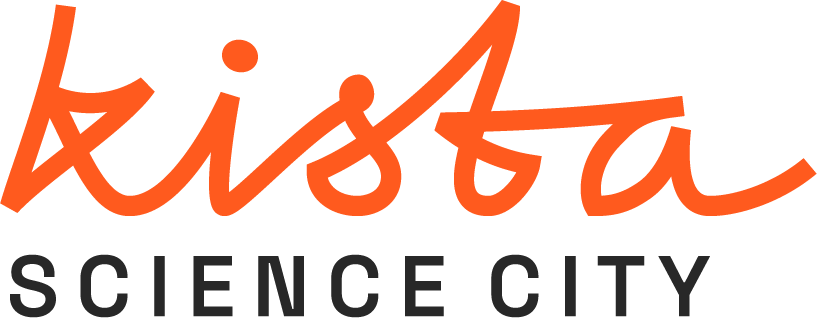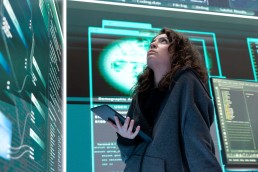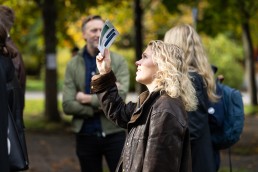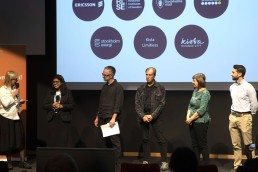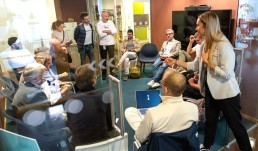Wittra Networks boosts cybersecurity readiness through support from Sweden Secure Tech Hub and eBuilder Security
Wittra Networks has strengthened its cybersecurity framework to meet rising regulatory demands and prepare for ISO 27001 certification. Through support from Sweden Secure Tech Hub, the company collaborated with eBuilder Security to carry out a penetration test and reinforce internal practices.
“The support we received made a clear difference — not just for the certification process, but for strengthening confidence in our daily cybersecurity work, both internally and among customers,” says Johan Kullander, Senior Business Development Manager at Wittra Networks, a subsidiary of Nida Tech Sweden.
Connecting expertise with real needs
Wittra Networks develops connected RTLS and sensor solutions that enable asset tracking and environmental monitoring in complex industrial settings. Its clients include organisations with high security requirements, such as Arlanda Airport — making information security and regulatory compliance central to how the company operates.
When preparing for ISO 27001 certification, Wittra Networks learned about the support available through Sweden Secure Tech Hub via Kista Science City. The hub connected the company with eBuilder Security, a Kista-based firm with more than 15 years of experience providing cybersecurity services to public and private organisations.
The collaboration focused on conducting a penetration test — a key step in meeting the requirements of ISO 27001 and the NIS2 directive. Over two weeks, eBuilder Security carried out a structured, five-phase assessment tailored to Wittra Networks’ specific systems and needs. The work provided detailed insights into system vulnerabilities and clear guidance for strengthening internal routines.
Beyond the immediate outcome, the project also helped Wittra Network expand its network of trusted cybersecurity partners — an important asset for companies operating in regulated and safety-critical environments.
Strengthening Sweden’s cybersecurity ecosystem
For many technology-driven SMEs, building strong cybersecurity has become just as essential as developing core products. As standards tighten and customer expectations rise, smaller companies often need to match the security level of much larger organisations — but without the same internal resources.
“Working with smaller companies allows us to bring cybersecurity practices closer to the people behind the systems,” says Per Häggdahl, Head of Business Unit & CISO at eBuilder Security. “When those insights reach across the organisation, cybersecurity becomes part of everyday operations rather than a separate exercise.”
By enabling collaborations like this one, Sweden Secure Tech Hub helps SMEs access targeted expertise, raise their security standards, and build resilience across Sweden’s digital economy.
_____
Interested in strengthening your company’s cybersecurity?
Contact sakarias.strand@kista.com to learn about ongoing initiatives and support.
Sweden Secure Tech Hub is a national innovation hub working to strengthen SMEs’ capacity in cybersecurity. It is co-funded by the European Union and run in collaboration between Kista Science City, Blue Science Park, Linköping Science Park, Luleå Science Park, Ideon Science Park and Lindholmen Science Park.
Integrating drones into city life: Stockholm takes next step
The Swedish capital is taking another step toward integrating autonomous systems into city life. In October, the City of Stockholm tested a “drone-in-a-box” system on the roof of Farsta swimming hall — the first time a large-scale station of this kind has been used in a Swedish city environment.
The demonstration was part of CITYAM, an EU-funded project that helps European cities explore how drones can support public services. For Stockholm, the aim was to understand what it actually takes to operate such a system safely in a dense urban setting — from regulations and permits to coordination on the ground. The test marks a shift from technical demonstration to operational learning, showing how large cities can integrate drone technology into existing infrastructure and operations.
“Projects like this help cities move from concept to practice,” says Karolina Pamp, Project Manager Mobility at Kista Science City. “They show how new technology can fit into daily routines rather than remain on the drawing board.”
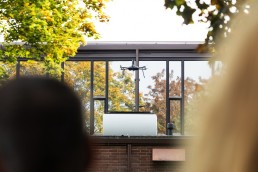
Putting autonomy to the test
The drone-in-a-box system, supplied by Nokia, allows a drone to take off and land automatically from a fixed station that also stores and charges the aircraft. A remote pilot and visual observers were part of the crew on site to ensure regulatory compliance and safety. In time, the goal is to manage these flights remotely — a change that could make operations more scalable and cost-effective than having a pilot for every mission.
Unlike trials carried out in controlled areas, the Farsta test took place in an active neighbourhood, surrounded by people and traffic. It offered a glimpse of how autonomous systems perform when they meet the pace of real city life — and what that means for future use. Over time, such systems could support city operations ranging from infrastructure inspections to environmental monitoring and emergency response.
Coordination on the ground
Before the test, the practicalities had to line up. Rooftop access had to be secured, electrical installation completed, safety procedures reviewed and communication with the local community established. Residents were informed in advance so people knew what was happening and why.
Each step tested the same issue many cities now face: how to introduce new technology within existing systems and responsibilities — a process that depends as much on people as on hardware.
“True integration comes from collaboration and public awareness, not distance flown in kilometres,” says Isabelle Nyroth, technical advisor at Kista Science City. “What we saw in Farsta was that principle in action — different actors working together to take steps toward making drone operations part of everyday city life.”
Next steps
The outcomes from the Farsta trial are now being analysed to support Stockholm’s continued work on drone integration. This includes refining procedures and safety routines, and clarifying how different departments and partners can collaborate around new technologies.
By sharing the results openly, the project helps other cities and organisations build on what has been learned — bringing drone-based services one step closer to becoming a safe and trusted part of everyday urban life.
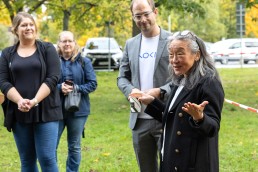
____
CITYAM is an EU-funded project supporting European cities in preparing for the safe and responsible use of drones in urban environments. The Stockholm pilot was delivered by Kista Science City together with the City of Stockholm, Nokia and project partners.
For more information, contact karolina.pamp@kista.com
Digital twins in practice: Lessons from Digital Vision Kista
How do we create alignment and shared visions in multidisciplinary projects — and truly understand how others are affected? The answer often lies in the mix of perspectives. When researchers, city planners and companies work side by side, tools that might otherwise remain abstract become solutions that guide real decisions.
That was the starting point for Digital Vision Kista, a three-year initiative that explored how digital twins can support data-driven cooperation and decision-making across city organisations. By visualising complex systems and connecting different data sources, the project aimed to help stakeholders look beyond their own organisational scope and engage in discussions with others.
The method
Digital Vision Kista was part of the national Smart Built Environment programme, which supports digital transformation and innovation in urban development. The project followed the Triple Helix model — bringing together the public sector, industry and academia to combine their expertise. Partners included the City of Stockholm, RISE, Ericsson, Kista Science City, Kista Limitless, Stockholm Exergi and S:t Erik Kommunikation, together with universities and students.
Unlike many initiatives, Digital Vision Kista began not with a technical solution, but with the people and processes it aimed to support. The project was built around the idea of the digital twin as a collaboration tool — a way to build shared understanding and enable data-driven dialogue between departments and organisations. By starting from everyday work and existing tasks, the project could explore how a digital twin might genuinely help colleagues coordinate decisions in their daily operations.
This setup made it possible to combine technical expertise with real-world needs. As a result, the work could move forward in ways that were meaningful for both those developing the technology and those applying it in practice — from city departments to utilities and emergency services.
The process
The project started by identifying concrete needs and challenges through workshops and interviews. From these insights, the project defined a set of user journeys — examples of how digital twins could create value in everyday work.
To explore these user journeys in practice, an interactive 5D model of Kista was developed. The model brought together data on traffic flows, stormwater and energy use, making it possible to visualise how areas changed over time — from ongoing projects to planned developments — and to explore alternative scenarios for how the district could evolve in the future. By combining real datasets in one visual platform, it offered a shared reference point for dialogue and decision-making, helping different actors coordinate earlier in the process. The platform evolved iteratively as new needs were identified, gradually forming an early prototype for future collaboration and data-driven decision-making.
Building on this foundation, the project focused on eight main user journeys that could demonstrate the practical value of digital twins. Examples include coordinating underground infrastructure projects, simulating energy use in new housing areas, analysing urban resource flows (Reflow), supporting emergency services and creating safer, more attractive public spaces. A series of articles describing these user journeys in more detail is being published at digivis.se and smartbuilt.se.
“For many people, the single biggest use case is simply getting a shared picture of what’s happening in their area,” says Uwe Stephan, project manager at the City of Stockholm. “They want to know what the city has planned for nearby streets and public spaces, what other projects are underway close by, and how longer-term plans might affect them. Whether you work in a city department or a private company, having that shared picture makes it easier to coordinate and act at the right time.”
The ecosystem
Digital Vision Kista drew on the full strength of Kista’s innovation environment. Data from an intelligent traffic management testbed was integrated into the models, while collaborations with universities gave students the opportunity to experiment with live digital twin environments. This setup allowed research pilots, industrial projects and testbeds to intersect, creating synergies that would not have been possible in isolation.
One insight from the project was how prototype development can spark engagement even beyond the immediate partners. For example, a parking optimisation pilot at Ericsson attracted interest from stakeholders outside the project, highlighting the value of sharing progress openly and inviting others into the process. This kind of transparency helps build trust, social acceptance and broader participation.
By linking education, research and applied projects, Digital Vision Kista showed how an ecosystem approach can turn separate initiatives into shared progress.
Next steps
Although Digital Vision Kista has ended, the collaborations continue. New partners and funding are being sought to expand the work and carry the user journeys forward.
Building on what has been achieved, the next phase will focus on strengthening data-driven decision-making in complex urban environments. Through continued prototyping and testing, the partners aim to explore real challenges more deeply, align perspectives across organisational boundaries, and turn shared insight into practical progress.
“We now want to bring the results back into Stockholm’s work and scale up what fits our way of operating,” says Uwe Stephan. “That also means continuing to build together — data-driven transformation isn’t something any single organisation can achieve alone.”
For those involved, the value lies not only in what has been built, but in how it was built: through many disciplines meeting around the same table. That is how complex technologies move from concept to real-world use — and why projects like this matter for the future of our cities.
To learn more or explore potential collaborations, contact lucas.uhlen@kista.com.
Setting the agenda: Semiconductor Arena launches in Kista
Sweden’s semiconductor ecosystem now has a shared platform in Kista. Semiconductor Arena brings startups, industry and researchers together to develop skills, support companies and strengthen Sweden’s role in Europe’s semiconductor landscape.
The race for semiconductor sovereignty
Semiconductors power almost every modern system — from transport and energy to communication and health. As demand grows, Europe is investing heavily to reduce its dependence on external suppliers and secure local capacity.
Sweden has key strengths to build on: world-class research, advanced infrastructure and a strong base of specialist companies driving innovation. The challenge is to turn that technical know-how into industrial capacity, and to ensure Sweden plays a clearer role in Europe’s semiconductor future.
Semiconductor Arena
The launch of Semiconductor Arena marks a new phase for Sweden’s chip sector, bringing startups, industry and researchers closer together.
The Arena, developed by Kista Science City, KTH, RISE and Sting, is a neutral meeting ground where ideas can move beyond individual organisations and into shared initiatives. Here, companies and researchers from different fields can test ideas, share expertise and move projects forward together. By connecting strengths across the ecosystem, the Arena shortens the path from research to industrial impact and builds the networks and visibility that help companies grow.
The launch in Kista highlighted three priorities that will shape this work: attracting and training more talent, enabling companies to scale in Sweden and connecting regional strengths with both Sweden’s national strategy and Europe’s semiconductor agenda.
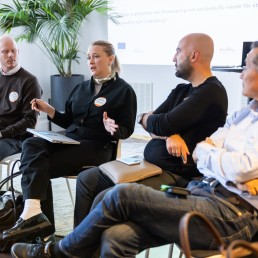
Building Sweden’s talent pipeline
The skills gap is one of the semiconductor sector’s most pressing challenges. Established companies point to an urgent need for more engineers and stronger incentives to enter the field.
“One concrete action is to reach engineers earlier in their academic journey so they see Sweden — and Stockholm in particular — as a strong hub with real career paths,” says Niklas Svedin, CTO and co-founder of Silex Microsystems, one of Sweden’s leading semiconductor companies.
Startups share the concern but see a different missing link: the difficulty of giving students and researchers clear entry points into real projects. “The most urgent need is structured competence initiatives that make it easier for students and researchers to engage with industry,” adds Louise Ribrant, VP of Business Development at Myvox, a startup specialising in MEMS ultrasound technology.
Semiconductor Arena is set up to address these needs, from early visibility to practical entry points. In the months ahead, the Arena will roll out initiatives to connect students with companies — starting with a thesis fair. Alongside this, the Electrum Lab will be made more accessible as a shared national resource, giving innovators hands-on access to state-of-the-art equipment.
Beyond engineers, companies also stress the importance of technicians and vocational roles to support large-scale production. To meet this need, the Arena will introduce new vocational training offers, preparing more people for hands-on roles in production.
Creating conditions for growth
Alongside the need for talent, another challenge for Swedish semiconductor companies lies in scaling their business. Moving from a small team to an established company is difficult. Development cycles are long and capital needs are high — and with limited financing options in Sweden, promising startups are too often acquired abroad, taking both competence and value with them.
Semiconductor Arena lowers these barriers by helping companies access infrastructure, connect with investors and build stronger ties across industry and academia.
One example of this approach is Sting’s Test Drive programme, which now includes a dedicated track within Semiconductor Arena to support researchers and startups. Test Drive is a short, workshop-based format that helps teams explore whether an idea can become a company. Concepts are tested with investors and mentors, giving them early clarity, confidence and networks.
“Being part of Semiconductor Arena connects us to a stronger innovation ecosystem at a critical time for both Sweden and Europe,” says Louise Ribrant of Myvox. “The Arena is a way to access competence, infrastructure and partners that can help accelerate development and commercialisation.”
Turning regional strengths into national influence
Sweden’s semiconductor sector has expanded quickly in recent years. Strong research environments, new startups and regional hubs are all contributing to a broader and more dynamic ecosystem. Yet much of this growth has developed in parallel, with initiatives often moving forward without alignment. Without stronger coordination, these efforts risk fragmenting — weakening Sweden’s ability to influence Europe’s semiconductor agenda and build long-term resilience.
Semiconductor Arena makes coordination day-to-day practice. Firmly rooted in Stockholm’s ecosystem, it gives local companies and researchers greater visibility by mapping actors and capabilities, showing who does what and where. By highlighting Stockholm’s semiconductor strengths, the Arena also makes it clearer what the ecosystem can contribute to Sweden’s national strategy and Europe’s semiconductor agenda.
Ultimately, coordination is about positioning — ensuring Sweden is not just part of Europe’s semiconductor agenda but able to shape it. As Niklas Svedin notes, self-sufficiency has become a central issue in Europe, making it urgent to put the semiconductor industry firmly on Sweden’s agenda. “The Arena helps connect industry, academia and policymakers — creating a stronger collective voice,” he says.
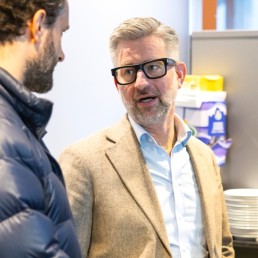
Looking ahead
Semiconductor Arena has brought Sweden’s chip sector into closer dialogue, turning collaboration into a working method rather than an exception. The next phase will build on this momentum: translating shared priorities into concrete initiatives — from clearer student pathways to new international connections.
The direction will be set by the ecosystem itself. As new needs emerge — whether in training, infrastructure or policy dialogue — the Arena provides a place to meet them collectively. Anchored in Stockholm and connected to national and EU strategies, it offers Sweden a stronger platform to act collectively in the global chip race.
Do you want to get involved? Reach out to hanna.eldh@kista.com
—
Semiconductor Arena is co-funded by the European Union and Region Stockholm and is run by Kista Science City, KTH, RISE and Sting.
